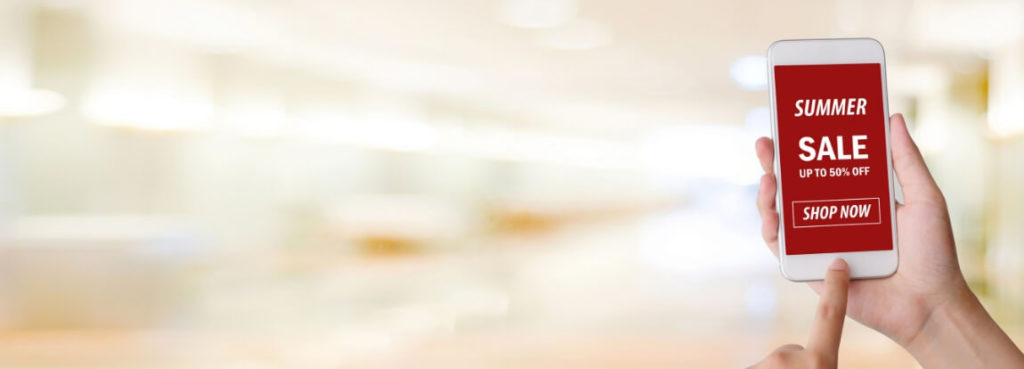For many brands, a sale is a great way to capitalize on summer excitement. Your customers are planning their vacations, starting big projects, and spending more time outdoors. Even if your products don’t depend on sunny days, discounting your products in honor of summer can help you attract new customers and bring back your old ones.
But if you want to get the most from your summer sale, you’ll need to do more than slash prices.
Here are four tips to help you maximize your summer sale.
1. Make buying convenient
When you’re spending time and money on ads, partner email sends, and creating content to promote your summer sale, you’re going to wind up with a lot of people on your website who have never heard of your brand—let alone created an account with you.
You could focus on generating new accounts by restricting the sale to your site or not highlighting major retailers that sell your products. But if you do that, those new accounts will come at the cost of losing sales—because you’re not letting them buy in the way that’s most convenient for them.
Just as consumers develop loyalty to the brands they love, they also develop loyalty to retailers. They get used to shopping at particular online stores and enjoying specific perks, like buy online and pick-up in store (BOPIS), free two-day shipping, discounts for using a special credit card, or other rewards points. And since they shop at these places all the time, they don’t have to create an account to buy. They can purchase your product with a click.
That’s extra important when you’re running a promotion where you’re bound to have a higher percentage of people who have never purchased with you before. If the only way to buy is through you, you’re not just asking them to make the commitment of spending X amount on your product. You’re asking them to commit to creating a new account and sacrifice the perks they know and love.
If you want to maximize sales, you need to create convenience, not friction. This is why many of the biggest brands use where to buy solutions to highlight local and online retail partners and display up-to-date stock and pricing information. It creates the smoothest path from your marketing to your site to purchase.
2. Measure the full impact of your marketing
If someone clicks your summer sale ad, explores your product page, and goes to an online retailer, what happens? Do they buy your product? Do they buy from a competitor? Do they leave without making a purchase? Did they leave the tab open, talk to a spouse, and buy it a couple of days later?
You have no idea. And that means your marketing department doesn’t know whether or not their efforts are effective because they only have access to the data that comes from your own website.
A good where to buy solution doesn’t just show your customers where they can buy your products. It also shows you where your customers bought your products—even if they purchased days later, on a retailer’s site. These insights help you see which promotion efforts are actually working (and which ones aren’t), so you can focus your energy in the areas it will make the biggest impact.
3. Create a follow-up plan for new customers
Even when you highlight your top retail partners, plenty of your website visitors will convert directly on your store, where they can check out without having to navigate a retailer’s site.
So what are you going to do with all those new accounts? This first purchase could be the start of an ongoing relationship. But if the only follow-up interaction your new customers have with you is a confirmation email, you’re missing out.
Ideally, you’d have an email onboarding campaign designed to guide customers into one of your various email lists—whether that’s a list where they can learn about future sales and deals, a newsletter, or something else.
The key is to make sure your first few communications with new customers directly relates to their purchase. You could send them an email about how to get the most out of the products they ordered, or a free guide to dealing with a problem your product helps solve. Some brands even use follow-up emails to immediately upsell customers on add-on products that relate to their purchase. (And for Peak Design, it works!)
The point is to find relevant ways to stay connected with your new customers, so you can both get more out of the relationship in the future.
4. Watch out for common ecommerce mistakes
It can take weeks, even months to prepare for a big sale. After all that work, the last thing you want is for a simple mistake to cost you sales. Many of the most common ecommerce mistakes have to do with linking to online retailers, such as sending your customers to:
- A broken or outdated link
- A retailer’s home page (instead of your product page)
- A search results page (which could include your competitors!)
There are lots of little things brands do all the time that ultimately come down to neglecting their customer’s experience. Focus on providing the best possible shopping experience, and you’ll avoid a lot of these mistakes—especially if you have the tools to catch them.
Sell more this summer
If you want to move as much product as possible, you need to leverage online retailers. At PriceSpider, we give brands like you the tools to streamline the path to purchase and monitor your brand everywhere it appears. We also help you collect advanced insights from in-cart data and track the results of your marketing—even when your customers buy from retailers.
Want to see what our Where to Buy tool can do for you?
Contact us to schedule a demo.

